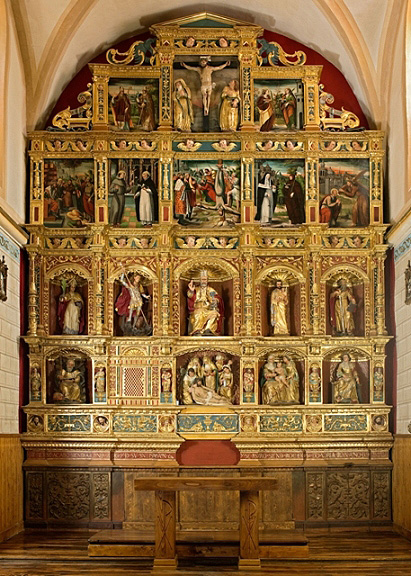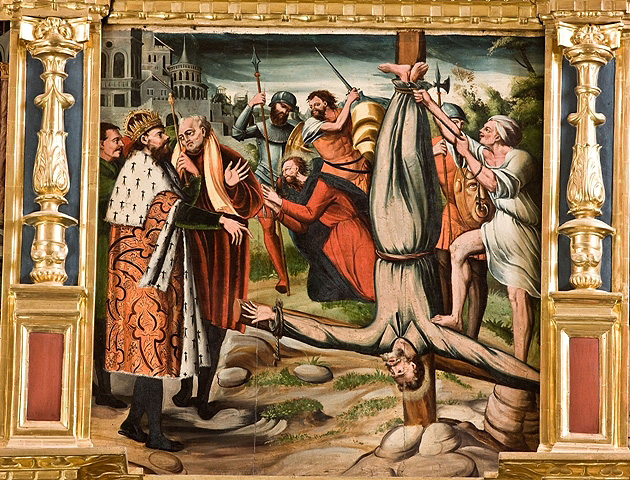Piece of the month of December 2010
THE MAIN ALTARPIECE OF THE PARISH CHURCH OF EGUIARRETA
María Josefa Tarifa Castilla
Chair of Navarrese Heritage and Art
The parish church of Santa María de Eguiarreta is presided over by a high altarpiece dedicated to Saint Peter, in Renaissance style, a mixed work made up of pictorial scenes and sculpture carvings that was restored in 2010 thanks to funding from the department de Cultura y Turismo-Institución Príncipe de Viana, restoring the altarpiece to part of its original splendour, recovering the colouring of the 16th century painting panels, which has allowed us to appreciate its quality and pictorial style with greater precision, although the gilding and polychromy applied in 1909 by Florentino Istúriz has been maintained on both the masonry and the wood carvings.
The altarpiece was documented in 1966 by Jimeno Jurío, whose carving and masonry work was carried out at position by Juan de Landa, an assembler based in Villanueva de Araquil, who by October 1540 had completed the architecture of the piece, which was still blank. A few months later, on 1 January 1541, he was commissioned to make six large images for the same altarpiece, specifying that one of them should be of the Virgin Mary and Child. The work was completed by 1548 and was valued at 162 ducats. In addition to this work de Landa, the altarpieces of Ichaso, Udabe, Beramendi (now disappeared), and Villanueva de Yerri, the latter together with his father-in-law Miguel Marsal, were completed in 1545.
The architectural design of the Eguiarreta altarpiece is the result of Landa's work , which is based on a sotabanco that starts from the floor, finely carved with unpolychromed grotesques, followed by a bench, three sections of five aisles and an attic of three aisles, the central one topped with a triangular pediment. The first two sections house sculptures of San Antón Abad, group del Santo Entierrro, Santa Ana, the Virgin and Child, and Santa Catalina under niches, followed on the second level by the figures of a holy bishop, San Miguel Arcángel, the titular San Pedro at Chair, San José con el Niño (baroque) and San Pablo, the altarpiece being finished off in the central scene of the attic with the group del Calvario. From the beginning, the altarpiece included in the Renaissance design of the first body a space on the side of the Gospel destined for a tabernacle to hold the Eucharistic Species. agreement Later, in 1640, in accordance with the Tridentine guidelines, a new tabernacle was placed in the middle of the altar by Francisco de Olmos, carver, and Juan and Antón de las Heras, painters, residents of Asiáin, which has not survived to the present day, a space that currently remains empty.

High altarpiece of Eguiarreta.
Juan de Landa and Ramón de Oscáriz. Mid 16th century. Photo: Antelan S.L.
Once the masonry and sculptural part of the altarpiece had been completed, the seven pictorial panels that make up the altarpiece were commissioned from the painter Ramón de Oscáriz, a resident of Pamplona, who we know from enquiry in the parish account books that he was already working by 5 November 1550, as opposed to the date given up to 1551, work , which he completed in 1553, and was also responsible for gilding the architecture of the altarpiece, his entire work being valued at 269 ducats and 3 and a half reales. It is therefore the first documented work by the artist, which had already been attributed to him by Pedro Navascués in 1965, and documented by Jimero Jurío a year later. With regard to the iconography of the seven panels depicted, Oscáriz sample has always preferred paired saints, such as Saint Francis and Saint Dominic, Saint Fermín and Saint Babil, Saint Brigida and Saint Marina, Saint Lucia and Saint Barbara, to which he added episodes from the life of Saint Peter and Saint Paul, such as their martyrdoms, the miracle of both before the emperor Nero and the scene of Quo Vadis, themes that he would deal with in other Navarrese altarpieces.
Ramón de Oscáriz is the leading figure in one of the most important Pamplona workshops of the second half of the 16th century, as García Gainza studied, whose pictorial style developed between the Hispano-Flemish Gothic tradition of the first third of the 16th century and the new Italian trends imported in the mid-16th century. Landscape is a Flemish ingredient in Oscáriz's painting. The foregrounds are painted in stony ground, dotted with oval stones of regular size, next to which grow small grasses of various types, as can be seen in the panel of the Martyrdoms of Saint Peter and Saint Paul by Eguiarreta, while the backgrounds present deep, green landscapes with lush vegetation covered by sky-like horizontals, the highest part of which is nocturnal.
Also very much to the painter's taste are the architectures that, without exception, share the background with the landscape. We often see a walled city with its battlements and buildings, including a circular tower with two floors of arcades and a conical spire topped by a sharp spire, as exemplified by the scenes of the Miracle of St Peter and St Paul before Nero, the Martyrdom of St Peter and St Paul and the Apparition of Christ to St Peter in Rome or Quo Vadis.
The enquiry of Italian prints justifies the frames of representation with niches, galleries or courtyards with semicircular arches and classical columns with which the painter obtains perspective, a good example of which is the panel of Saint Francis of Assisi and Saint Dominic, in which Oscáriz places both saints on a checkerboard tiling and framed by a fantastic Classicist architecture in the background, a quadrangular courtyard formed by a high pedestal on which stand marble columns with pinkish shafts and classical gilded capitals, on which rest semicircular arches, which in turn give way to a second body articulated by a simple balustrade railing.

Detail of the martyrdom of Saints Peter and Paul.
Ramón de Oscáriz. (1550-1553). Photo: Antelan S.L
Finally, we draw attention to the panel that has so far been interpreted as the Miracle of Saints Peter and Paul expelling demons from the body of a possessed man in the presence of the Emperor Nero. In our opinion, the scene represents another episode in the life of Saint Peter and Saint Paul, which also took place in the presence of the emperor Nero and in the city of Rome, when these apostles confronted Simon Magus for the deceptions he was playing on the people. Simon, in revenge and to outrage the Christians, summoned the Roman people to witness his ascent to heaven, and after climbing a very high tower, he threw himself into the void and flew away, all this in the presence of Nero. Then St. Paul began to pray and St. Peter ordered the demons to release Simon, who immediately ceased to be suspended in the air and fell to the ground and died instantly. This is the episode that we believe is depicted in Eguiarreta's panel, with Simon's lifeless body on the ground in a marked foreshortening that gives depth to the scene, while Saint Peter and Saint Paul look up and point to the unclean beasts perched in the sky that still make the gesture of having held the Magician, before Nero's furious gaze.
In this episode we see another of the characteristic features of Oscáriz's Flemish-rooted pictorial style, such as the attention to detail in the jewels and embroidery and the trivial aspects of the clothing. The painter likes to dress his figures in rich fabrics and furs, such as brocades, some in yellowish tones that imitate the gold of the Hispano-Flemish painters, as can also be seen in the episode of the martyrdom of Saint Peter, similar to the garments worn by the Magi in the Epiphany panel of the Inza altarpiece, the scene of the appearance of the archangel St. Michael to St. Gregory in the Cía altarpiece, or scenes from the life of St. John the Baptist in the Setuain altarpiece.
bibliography
NAVASCUÉS Y DE PALACIO, P., "Ramón de Oscáriz, pintor navarro del siglo XVI", Príncipe de Viana, nº 98-99, t. XXVI, (1965), pp. 103-106.
JIMENO JURÍO, J.M., "Authors and dates of the Eguiarreta altarpiece (Araquil)", Príncipe de Viana, t. XXXVII, (1966), pp. 227-228.
GARCÍA GAINZA, M.C., "Los Oscáriz, una familia de pintores navarros del siglo XVI", Príncipe de Viana, t. XXX, nº. 114 and 115, (1969), pp. 5-52.
TARIFA CASTILLA, M.J., "Una nueva atribución al taller pictórico de los Oscáriz: el retablo mayor de Inza", Príncipe de Viana, no. 244, (2008), pp. 271-310.
